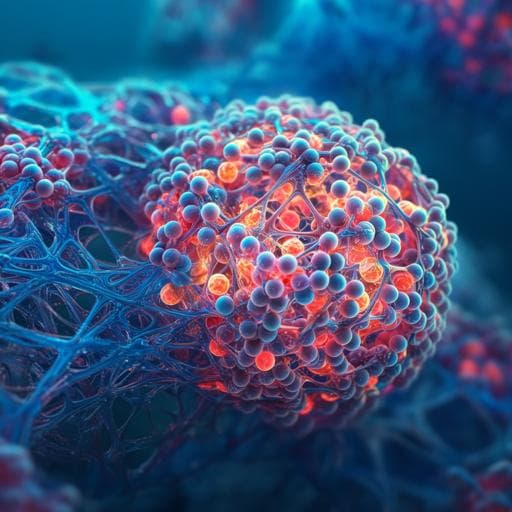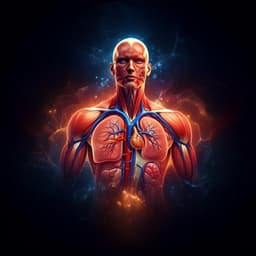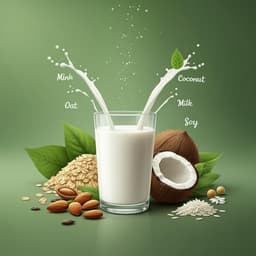
Environmental Studies and Forestry
Capturing colloidal nano- and microplastics with plant-based nanocellulose networks
I. Leppänen, T. Lappalainen, et al.
This groundbreaking research by Ilona Leppänen, Timo Lappalainen, Tia Lohtander, Christopher Jonkergouw, Suvi Arola, and Tekla Tammelin reveals how hygroscopic nanocellulose networks effectively capture harmful nanoplastic particles, offering promising solutions for environmental monitoring and recovery techniques in a water-scarce world.
~3 min • Beginner • English
Introduction
Plastic pollution is a growing environmental problem; fragmentation and primary sources generate microplastics (1 µm–5 mm) and nanoplastics (≤100 nm–a few µm). Nanoplastics pose particular risks due to small size, large surface area and colloidal behavior but are difficult to recover and quantify with existing filtration/elutriation methods, leaving a 1 nm–1 µm analytical gap. Nanocellulose, especially cellulose nanofibrils (CNF), offers high surface area and exceptional hygroscopic, water-transport properties. The study investigates whether hygroscopic nanocellulose networks can capture and enable quantification of colloidal nano- and microplastics, elucidates underlying mechanisms (hygroscopic transport vs. electrostatics), and examines environmental factors (pH, ionic strength) affecting adsorption.
Literature Review
Prior work documents widespread microplastics in marine and freshwater systems and accumulating evidence of nanoplastic presence in biota (algae, mussels, zebrafish) and even human placenta. Definitions of nanoplastics vary (upper limit 100–1000 nm), contributing to methodological ambiguity. Conventional recovery methods (filtration, flotation, elutriation, velocity-based separations) are suited to larger microplastics (>50 µm to tens of µm) and fail for submicron colloids, creating a detection and quantification gap for <1 µm particles. Efforts such as enzyme-based plastic degradation offer complementary strategies but do not address colloidal recovery. Cellulose nanofibrils are nanoscale, hygroscopic, water-responsive materials with large surface areas and have shown interactions with ions and nanoparticles, suggesting potential for capturing colloidal plastics.
Methodology
- Materials: Model polystyrene (PS) particles with defined sizes and charges: nanoplastics PS(Ø100 nm) and microplastics PS(Ø1 µm), both anionic and cationic. Polyethylene (PE) particles: fluorescent PE(Ø38–45 µm) for film capture tests and non-labeled PE(Ø200–9900 nm) fractionated to <450 nm for QCM-D. Zeta potentials measured for all particle types.
- Nanocellulose substrates: Native CNF (low charge, prone to hornification upon drying) and TEMPO-oxidized CNF (TEMPO-CNF, high anionic charge ~1.3 mmol g⁻1, retains hygroscopic swelling). Reference films: regenerated cellulose (RC) and polystyrene (PS). Self-standing films prepared by casting (CNF), TEMPO-CNF crosslinked with PVA for wet strength, RC via ionic liquid dissolution/regeneration, PS via solution casting. Ultrathin films for QCM-D prepared by spin coating on QCM-D crystals (with PEI anchoring for CNF/TEMPO-CNF; TMSC route for RC; PS in toluene), characterized by AFM and water contact angle.
- Microfluidic hydrogel capture: Native CNF hydrogel formed within microfluidic chip traps using 0.5 wt% CNF. Cyclic injections of fluorescent PS particles and water; fluorescence microscopy (ex 480 nm, em 515–535 nm) tracked real-time accumulation; analysis of spatial fluorescence profiles to assess penetration depth.
- Self-standing film capture and quantification: Films immersed 10 min in 0.1 g L⁻1 fluorescent PS dispersions (10 mM phosphate buffer, pH 6.8). Fluorescence spectroscopy used to quantify decrease in solution fluorescence pre/post immersion; particle numbers calculated from calibration and single-particle mass (PS density 1.05 g cm⁻3). For heterogeneous PE(Ø38–45 µm), mass recovery quantified from fluorescence change (particle counts not possible due to broad size distribution). Areas required to completely remove particles from set volumes were estimated.
- Surface adsorption studies (excluding network hygroscopicity): QCM-D (E4) tracked adsorption of PS(Ø100 nm) (stable as-supplied or purified to reduce stabilizers) and fractionated PE(Ø<450 nm) onto ultrathin CNF, TEMPO-CNF, RC, PS. Conditions: phosphate buffer pH 6.8 (10 mM), variations at pH 8 and 10, and NaCl additions (40 mM, 200 mM). Flow 0.1 mL min⁻1, ~1 h adsorption, followed by rinsing. Frequency (Δf) and dissipation (ΔD) monitored; hydrated mass contributions assessed.
- Image analysis and RSA modeling: Post-QCM-D, SEM imaged surfaces; custom image analysis (Matlab) quantified particle counts per area (handling dispersed and clustered cases). Random sequential adsorption (RSA) model used to fit adsorption kinetics and estimate adsorption coefficient k_a, occupied area per particle including coupled water (a, d_RSA), and surface coverage relative to theoretical jamming limit θ_c = 0.547. QCM-D mass rescaled using SEM-derived dry mass to estimate coupled water factors (ratio of QCM-D sensed mass to dry mass).
Key Findings
- CNF hydrogels capture nanoplastics and microplastics in flow: Fluorescence accumulation within CNF-containing microfluidic traps increased cycle-by-cycle for both PS(Ø100 nm) and PS(Ø1 µm), with greater net accumulation for positively charged particles. Nanoparticles penetrated deeper into hydrogels than microparticles; overall, CNF hydrogels showed higher capability to capture nanoplastics.
- Mechanism in hydrogels: Hygroscopic nanocellulose assemblies create capillary-driven water flux and diffusion, conveying particles into the network; large surface area enhances cohesion; negative CNF charge attracts cationic particles but does not prevent anionic particle accumulation.
- Self-standing films: TEMPO-CNF outperformed all films for both nano- and microplastics. TEMPO-CNF captured approximately one-third more anionic PS(Ø100 nm) than cationic, attributed to reduced initial electrostatic attraction allowing deeper penetration into the swollen network; oppositely charged cationic nanoplastics bind rapidly at the surface, partially hindering diffusion into the network. For PS(Ø1 µm), all films recovered more cationic than anionic particles, indicating stronger electrostatic effects for microparticles.
- Quantitative capacities and areas: To remove all anionic PS(Ø100 nm) from solution, required film areas were ~30 cm² for TEMPO-CNF vs. ~140 cm² for native CNF. For PE(Ø38–45 µm), required areas were ~16–17 cm² (CNF and TEMPO-CNF), evidencing non-specificity to plastic type and efficient capture of larger microplastics. Nanocellulose systems outperformed RC and PS references due to porosity and hygroscopicity; regenerated cellulose still captured substantial amounts despite lacking nanoscale porosity.
- High capacity: Up to roughly 20 billion PS nanoplastic particles per mg of TEMPO-CNF could be collected.
- Surface adsorption (QCM-D) without network effects: In model buffer (pH 6.8, 10 mM), PS(Ø100 nm) (stable and purified) adsorbed on native CNF, RC, and PS, but not on highly anionic TEMPO-CNF due to electrostatic repulsion. pH 8 and 10 yielded similar behavior (slight adsorption decrease on CNF/RC at pH 10); no adsorption detected on TEMPO-CNF. Increasing ionic strength (40 mM, 200 mM NaCl) screened electrostatics and increased adsorption on CNF and TEMPO-CNF. Fractionated PE(Ø<450 nm) showed no detectable adsorption on cellulosic surfaces in model conditions (instability and density mismatch), although self-standing films captured PE via network hygroscopic transport.
- RSA/image analysis couplings: Experimental surface coverage and kinetics quantified. Regenerated cellulose showed the highest adsorption probability (higher k_a), achieving ~50% of theoretical jamming coverage within ~1 h; particles occupied smaller effective areas, suggesting only hydration shell and electrical double layer limited packing. Native CNF achieved ~15% of theoretical coverage with minor differences between stable vs purified PS. PS surface had the lowest adsorption probability; purified PS improved adsorption relative to stable. Coupled-water factors indicated that for CNF and RC, ~2/3 of QCM-D sensed mass was water (factor ~3), and for PS ~3/4 was water (factor ~4).
Discussion
Findings demonstrate that nanocellulose networks capture nano- and microplastics primarily through hygroscopic swelling and capillary-driven water transport, funneling particles into a high-surface-area network where cohesion and interfacial interactions retain them. Electrostatics modulate capture: for microparticles, attractive electrostatics markedly enhance recovery; for nanoplastics, hygroscopic transport and nanoscale porosity dominate, with electrostatic attraction sometimes limiting penetration due to immediate surface binding. Surface-adsorption studies confirm that, absent network transport, adsorption depends on charge screening and substrate chemistry; TEMPO-CNF’s strong anionic charge repels anionic nanoplastics unless ionic strength screens repulsion. The RSA-based framework quantitatively links QCM-D responses, SEM-derived counts, and adsorption kinetics, enabling estimation of true surface coverages accounting for coupled water. Collectively, these outcomes address the analytical gap for submicron plastics by offering both practical capture media (hydrogels/films) and an interfacial quantification toolkit (QCM-D + image analysis + RSA), relevant for wastewater, laundry effluents, and on-site source capture.
Conclusion
The study introduces universal, plant-based nanocellulose materials—hydrogels and self-standing films—that efficiently capture colloidal nano- and microplastics irrespective of particle size, charge, or polymer type. The dominant mechanism is a synergy of high hygroscopicity and high active surface area producing capillary water transport and diffusion into a porous network, with interfacial interactions aiding retention. TEMPO-CNF films exhibit superior performance, removing all anionic PS nanoplastics with far smaller areas than native CNF and effectively capturing PE microplastics as well. A quantitative interfacial approach combining QCM-D, SEM image analysis, and RSA modeling provides adsorption kinetics, surface coverage, and hydrated mass insights, offering a toolset for nanoplastic detection and material design. Future work could extend to complex environmental matrices, on-site capture device development, scale-up to aerogels/cryogels, and optimization under variable ionic strengths and mixed pollutant conditions.
Limitations
- Model systems: Experiments used model PS and PE particles in controlled buffers; environmental nanoplastics often carry diverse contaminants and surface coronas, which may alter capture/adsorption.
- Fluorescent labeling and quantification: Recovery was quantified via fluorescence; labeling efficiencies, photophysics, and heterogeneous size distributions (for PE microplastics) introduce uncertainty; PE capture was reported as mass rather than particle counts.
- Film hornification effects: Native CNF films suffer hornification upon drying, reducing active surface area and swelling; performance comparisons depend on processing history.
- QCM-D interpretations: Surface adsorption studies required rescaling to account for coupled water and assume monolayer formation and RSA kinetics; these assumptions may not fully capture all interfacial complexities.
- Limited particle types/chemistries: While both PS and PE were tested, broader plastic chemistries and additives were not comprehensively examined.
- No field trials: Demonstrations were in laboratory conditions; performance in real wastewaters or marine samples with complex matrices remains to be validated.
Related Publications
Explore these studies to deepen your understanding of the subject.







